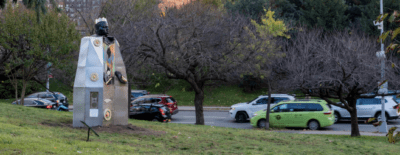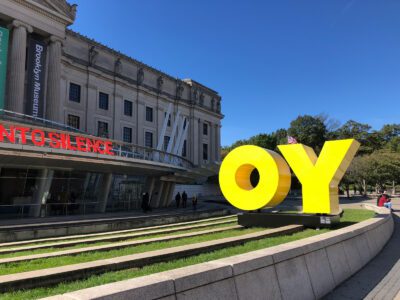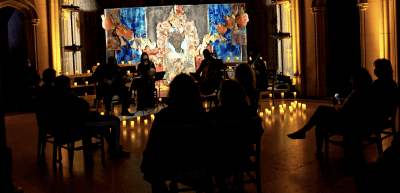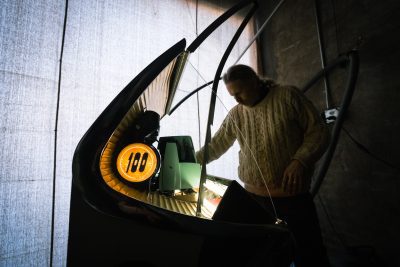From left: Kelli O'Hara, Renée Fleming and Joyce DiDonato (Photo: Evan Zimmerman / Met Opera)
‘The Hours,’ a Pulitzer-winning book and Oscar-winning movie, is now an opera, too
But you don’t have to go the Met to see it — “The Hours” will screen at BAM and in Sheepshead Bay this month
As the house lights dim and the curtain rises on the new Metropolitan Opera production of “The Hours,” the first thing one sees is a large clock showing real-life time ticking away, a symbol of this era-hopping story about one single day in the lives of three women from three different time periods, spanning1923 to 1999.
“What is tying these three women together?” asks librettist Greg Pierce, who answers his own question: “The answer is such a mystery. And that’s what really attracted me because I love putting something on the Met stage that really makes us think.”
Essentially “The Hours” is a complicated psychological drama centering on three women in a moment of crisis. The opera is based on Michael Cunningham’s Pulitzer Prize-winning novel of the same name — which has already spawned an Academy Award-winning movie, and is itself a riff on Virginia Woolf’s 1925 novel “Mrs. Dalloway.”
The Met’s production, with a luscious score by Kevin Puts, moves back and forth across timelines, telling three separate stories, each beginning with breakfast, involving the buying of flowers in preparations for parties and ending in sadness.
Described by Opera News as “a master polystylist,” Puts is also the recipient of a Pulitzer Prize for his breakthrough opera “Silent Night.” In “The Hours,” his music captures each of the three main characters in their separate eras. And Pierce does a wonderful job of reshaping Cunninghan’s prose into opera.
A lot of the storytelling happens through the chorus, which is used to express the characters’ interior thoughts. “Because Virginia Woolf and Michael Cunningham did so much with stream of consciousness, we thought that would be a great way to use the chorus,” Pierce tells Brooklyn Magazine. “The characters are fighting a battle inside their minds, so letting the chorus sing the voices inside their heads is sort of an X-ray into their brain.”
‘Is anything bigger than life or death?’
The three main heroines can neither see nor hear one another until the final moments of the opera, yet each separate narrative moves seamlessly from one to another through duets and ensembles which essentially transcend time. Clanging clock chimes register the hours going by, while a soft layer of strings suggest love and loneliness.
This trio of interwoven tales begins in the early 1920s in Richmond, a quiet suburb of London, where Virginia Woolf — played by mezzo-soprano Joyce DiDonato — is working on “Mrs. Dalloway” and grappling with depression. The second centers around a day in Los Angeles in 1949 where a pregnant Laura Brown (Broadway veteran Kelli O’Hara) escapes her unhappy married life by reading the passage from “Mrs. Dalloway” that Woolf is seen writing.
The third narrative unfolds in New York towards the end of the twentieth century, where Clarissa Vaughan (soprano Renée Fleming) is seemingly living out the plot of “Mrs. Dalloway.”
All three characters are haunted by their internal dilemmas, and all three divas sing achingly, painfully and beautifully about what haunts them.
Woolf is plagued by her history of mental illness as she fights off suicidal thoughts. Laura Brown lives with a son, is expecting a second child, and has a husband she does not love. A surprising kiss midway through her story suggests she may indeed be happier as a lesbian. (To divulge how Laura’s story ends would be a spoiler, but it creates a shocking revelation at the end of the opera.)
Clarissa Vaughn (Clarissa happens to be Mrs. Dalloway’s first name in the novel) is an editor who appears to be happy at home with a domestic partner and her daughter. But she is haunted by the fear that the best days of her life are behind her.
She is busy planning a party for her closest friend, Richard, who is dying of AIDS. In their youth Clarissa and Richard, in spite of their homosexuality, were lovers. There is a beautiful, nostalgic, scene when the two look back on their magical summer affair in Wellfleet when they were 19 years old.
“There are so many different storylines and themes,” says Pierce, which is what he says was so appealing to him as a librettist. “Because there is something so delicate and intimate and small, but at the same time it can get rapidly bigger. I mean, is there anything bigger than life or death?”
This “Hours” makes it clear that opera — like film and books — can effectively pull off temporal shifts, with some scenes appearing to take place across time or out of time entirely. That’s thanks to gentle vocal overlaps and proficient orchestration, under the baton of Yannick Nezet-Seguin.
This new “Hours” is a carefully balanced work focused on despair and the changing attitudes toward sexual identity. And the ending rends the heart: Finally, Cunningham’s three women are allowed to occupy one space and time, performing a trio that is a nod to Richard Strauss’s conclusion of “Der Rosenkavalier.” Here’s where opera offers a dramaturgical solution that is more poignant than film.
Having said all of that, watching “The Hours” on the big screen will likely be a superior experience to sitting in the opera house. And cheaper. Brooklynites can do just that on December 10 at Brooklyn Academy of Music (tickets here) or at the Regal UA Sheepshead Bay IMAX and RPX theaters (tickets).
Under the direction of Phelim McDermott (“Akhnaten”) “The Hours” sets seem too busy and overstuffed, making it difficult to really see the action on the stage. “The Met: Live in HD” simulcasts change the opera experience with their wide-screen presentations. These cinematic screenings let the camera focus the eye so that the busy-ness disappears as voices swell with loud and clear surround-sound. It will make for a relaxed and informal way to take in an opera — while munching on a bucket of popcorn and escaping one’s own internal drama for an afternoon.
You might also like 


























